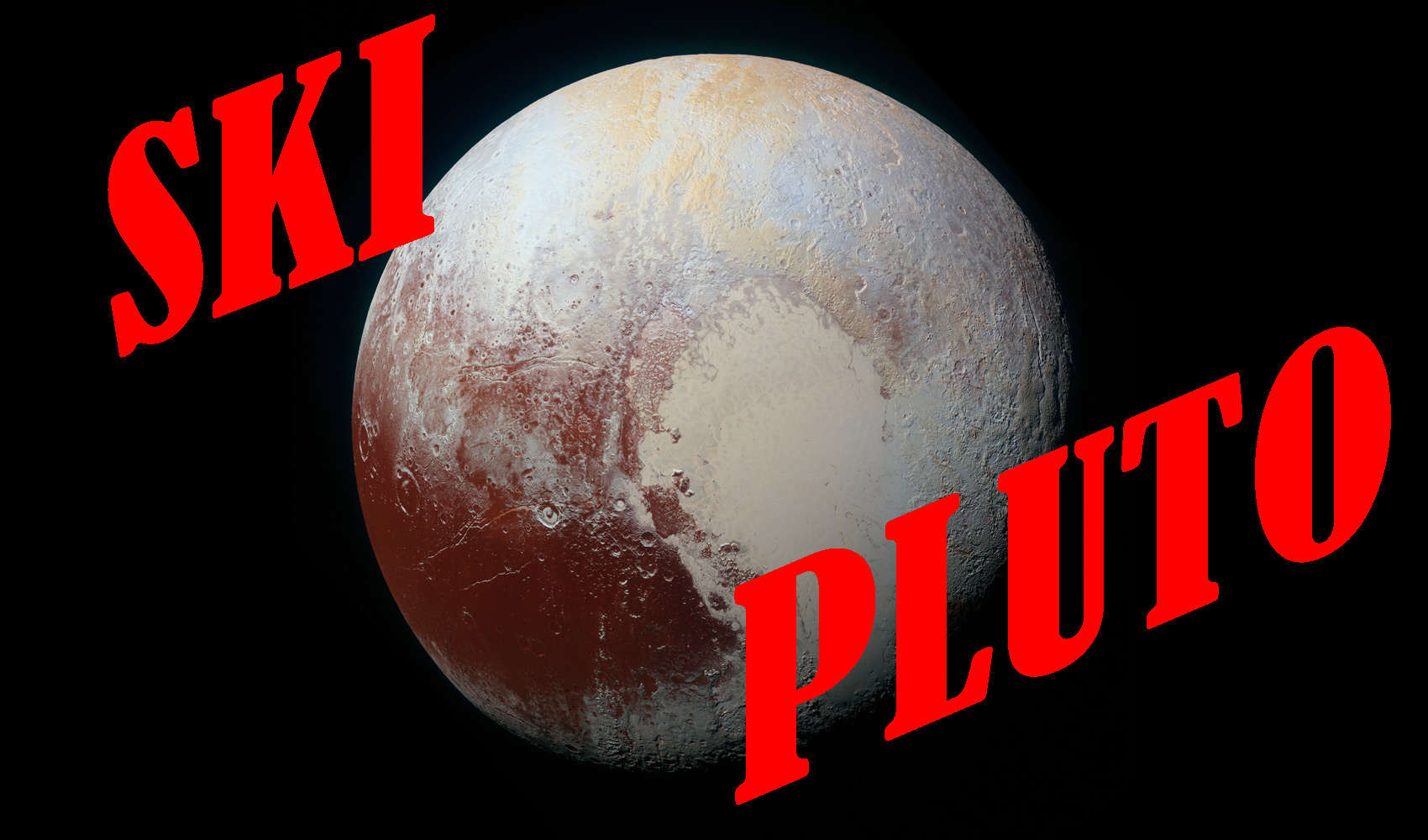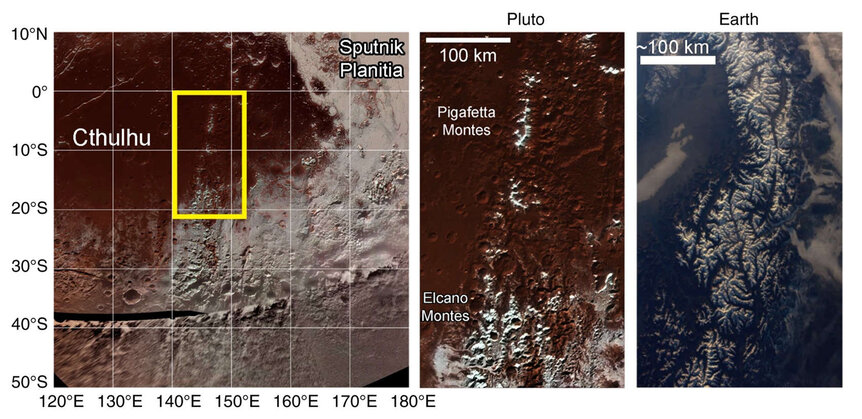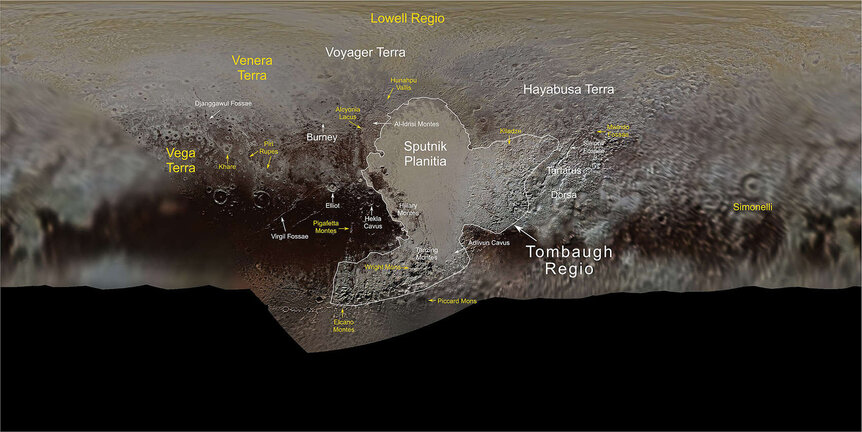Create a free profile to get unlimited access to exclusive videos, sweepstakes, and more!
Pluto's mountains are capped with... methane snow?

When the New Horizons spacecraft zipped past Pluto in July 2015, it revealed a bizarre world full of surprises. Giant plains of nitrogen ice, isolated mountains of what may be water ice frozen so cold it's harder than rock on Earth, and even very thin haze layers suspended in the very thin atmosphere.
One odd thing planetary scientists noticed was that some of those mountains were dark at lower elevations but very bright at their peaks, as if they were snow or frost capped. In fact, they resembled nothing so much as alpine peaks on Earth!
Of all the things to expect when seeing Pluto up close for the first time, hints of home were way down on the list.
But the resemblance is superficial. Those peaks aren't covered in water snow or frost. It's frozen methane.
That was unexpected, and explaining it is a bit difficult. But some scientists have come up with a reason this may be happening, and it relies on an important fact: Pluto works very differently than our own warm world in some specific ways.
Here, for example, our air is relatively dense on the surface (sea level) and gets thinner as you go up in elevation. Air near sea level is warmed by the ground, so it expands and gets less dense. It then rises, and if the air is humid when it gets up high enough and cools it'll form clouds. It may even condense to form snow, which then falls on mountain tops. Or, if it's blowing up and over a mountain, the water vapor may condense on the ground directly as frost. That's why tall mountains on Earth have white peaks.
But that's not how it works on Pluto. There are two big difference there. Well, to be clear, there are a lot of differences (temperature, gravity, and so on), but two that play a role in mountaintop frost. One is that the atmosphere is incredibly thin, about 13 millionths as thick on the surface as Earth's. The other is the presence of methane and nitrogen ice on the surface.
Pluto is cold enough that these two molecules, which are gases on Earth, are frozen. In fact, one of the most obvious features on Pluto is Sputnik Planitia, the western lobe of the giant heart-shape region made so famous in the New Horizons images. That's a flat plain covered in nitrogen ice. To the west of it is Cthulhu Macula (yes, seriously; and macula means “spot”, like a dark spot). It's darker, possibly due to haze particles in Pluto's atmosphere freezing out there; these tend to be darker in color, red and orange and brown.
But methane is good at absorbing sunlight, weak as the Sun is from Pluto's vast distance of 4.5 billion kilometers. So it warms pretty well, turning from a solid ice directly to a gas (this process is called sublimation). It goes up in the atmosphere, but a weird thing happens: Because the air is so thin, it doesn't do a very good job warming the ground beneath it. So the ground stays cold, while the air above it is warmer. That's the exact opposite of what happens on Earth!
And also a stumbling block for explaining why the mountains have methane frost on them. If it gets warmer with height, then air won't flow up mountains and cool, like it does on Earth. In fact, the air flows down them, something which on Earth is called katabatic winds (which I mention because it's a cool name, and we get them here where I live near the Rockies in Colorado). So how can methane condense on the peaks?
The scientists came up with an idea. In the northern plains, especially around Sputnik, the surface nitrogen ice sublimates in daylight. It goes up, then flows south and down, where it cools. This creates a north/south flow of air. Methane in the atmosphere is carried along with this flow.
Because the thin air can't warm the mountains, the ground is still very cold there, cold enough that the methane hits them and condenses. It then forms the bright white frost seen in the New Horizons images. Tada!
The scientists note that north-facing crater walls and rims in the lower plains also seem to show bright white frost. This fits, too, since the walls are colder due to being out of the sunlight, so the methane can condense on them. The rims are higher up, so they get frost for the same reason the mountaintops do.
That's so weird. The peaks on Pluto are covered in frost like ones on Earth, but because the air is flowing down them, not up.
I wondered (again, I live in Colorado) if it would be possible to ski on Pluto's mountains — assuming you had a spacesuit with a really good heater in it. But in the research paper the scientists find that the frost is likely only millimeters thick. That's pretty thin… but wait. Pluto's gravity is only 6% of Earth's. I'd only weigh 11 pounds on Pluto! Even with a heavy spacesuit I'd probably only total 20 pounds. You might need long, broad skis to distribute that weight and not crush the methane ice, but it might just work.
Of course, getting there might be an issue. It took New Horizons almost a decade, and it was one of the fastest probes ever launched. Plus it couldn't carry enough fuel to slow down, so it just flew right on by and is now a billion kilometers deep into the Kuiper Belt. But hey, those are logistical problems. I'll let someone else worry about those.
Now, how to design a spacesuit for -240°C (-400°F) and also be able to see the moguls in sunlight dimmed substantially by distance...





























